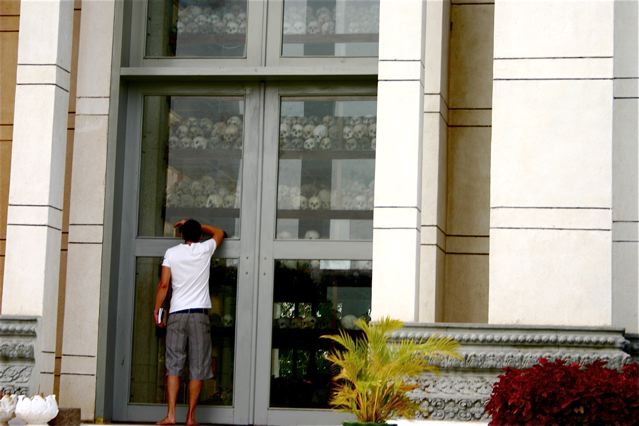
Unraveling the policies of the Khmer Rouge: targeted or mass killings?
Jared Ferrie, MRG’s Regional Information Officer in Phnom Penh, examines the implications for minorities of the first verdict of the Cambodian war crimes tribunal.
When the Cambodian war crimes tribunal delivered its first verdict recently, reactions varied from relief to anger. Relief because three decades after the fall of one of the bloodiest regimes of the 20th century, Cambodians have now been provided some small measure of justice; anger because many felt the judges let a war criminal off with a relatively light sentence.

Kaing Guek Eav, better known by his revolutionary name, “Duch”, was given 35 years for running a prison where as many as 17,000 people were tortured before being killed. But the court reduced his sentence by 16 years, taking into account a period of illegal detention at a Cambodian military prison, as well as time served while awaiting his trial.
This means Duch could walk free after serving a further 11 years.

The prison, a former high school called Tuel Sleng that became known as S-21, was where the Khmer Rouge sent many of its perceived enemies. There, they were tortured into confessing that they were spies working for the Soviet Union, the United States or Vietnam. Among the victims were members of minority communities whom prosecution lawyers say the regime targeted in particular.
The regime’s attacks against minority communities were raised during the Duch trial. But the issue is likely to take on much greater importance in the next case, when four former members of the regime’s ruling clique stand trial on charges of war crimes and crimes against humanity. As of December, each leader is charged with genocide, stemming from the regime’s history of targeting minority communities.

While the regime carried out mass executions of Cambodians in general – as many as 2 million people died of execution, starvation or disease during their four-year rule – prosecutors succeeded in arguing that the Khmer Rouge targeted minority Cham Muslim and Vietnamese populations in particular.
Members of the Cham community interviewed immediately after the genocide charges were announced said they supported the judges’ decision. Tolosh Kor Seum, 42, and Mok Sika, 69, plan to testify on behalf of victims. Both said they agreed that Khmer Rouge leaders should be charged with genocide.
Tolosh said he decided to testify because he wanted to make sure an historical record exists for the next generation. ‘I want them to know how many Muslim people have been killed by the regime.’

The Khmer Rouge took a radical interpretation of communism that conflicted with Cham religious beliefs and traditions, which the regime attempted to eradicate. The result was disastrous for the Cham, members of which were the only group to rise up against the regime in armed rebellion. In response, the Khmer Rouge carried out massacres, including one that wiped out an entire Cham community on the island of Koh Phal.
In his book, The Pol Pot Regime: race, power and genocide under the Khmer Rouge, historian Ben Kiernan accuses regime leaders of using rhetoric about ridding Cambodia of those not part of the majority Khmer ethnic group.
According to research conducted by another scholar, Gregory Stanton, Cham Muslims experienced a mortality rate of more than 50 percent, while the rate affecting the general population was about 21 percent.
In March 1999, a United Nations panel of experts concluded that the regime’s targeting of minority Cham and Vietnamese communities constituted genocide, which the UN defines as ‘acts committed with intent to destroy, in whole or in part, a national, ethnical, racial or religious group.’
Some scholars, however, disagree that charges of genocide should play a part in the upcoming trial. In a telephone interview from Melbourne, where he teaches at Monash University, historian David Chandler said it would be hard to prove in court that the regime targeted minorities specifically. He said the new charges could create a ‘smokescreen’ used by the defence to stall the proceedings.

All four remaining defendants are elderly and have health problems. There are concerns that they may not live to see their trial through.
Philip Short, who wrote a definitive biography on the Khmer Rouge’s leader, Pol Pot, also disagreed with the genocide charges. ‘Vietnamese were indeed targeted and killed – and not only Vietnamese, but Khmers who had any contact with Vietnam and were suspected (almost always wrongly) of being traitors,’ he said in an email. ‘But they were killed for political reasons, not simply because they were of the Vietnamese race.’

He said Cham were slaughtered because of their refusal to adhere to Khmer Rouge orders, and in response to their armed rebellion. In their attacks against the Cham and Vietnamese minorities, Short characterized the regime as being motivated primarily by politics rather than genocidal intent.
The policies of the Khmer Rouge toward minority communities is sure to be one of the most hotly debated issues in the next trial, which is expected to start sometime in 2011.
—
This article reflects the sole opinion of its author and does not engage MRG’s responsibility.